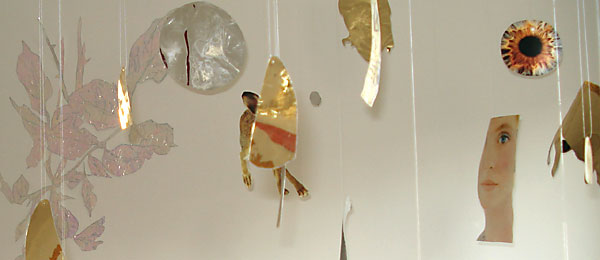 Incantations are typically verbal; they are the words spoken, often in ritual repetition to invoke magic, charms, spells. What would happen if one imagined these utterances as visual? With their mouth of origin being an optical rather than an auditory apparatus? This kind of questioning and experiment – a veritable proposal for a metamorphosis of the senses – is at the “heart” of Jennifer Murphy’s latest body of work.
Incantations are typically verbal; they are the words spoken, often in ritual repetition to invoke magic, charms, spells. What would happen if one imagined these utterances as visual? With their mouth of origin being an optical rather than an auditory apparatus? This kind of questioning and experiment – a veritable proposal for a metamorphosis of the senses – is at the “heart” of Jennifer Murphy’s latest body of work.
Drawing heavily on repeated imagery from iconic enchantments, and even occult mystery, Murphy’s art orbits, literally and figuratively, within and around the worlds of fantasy fiction and conceptual sorcery. Six playful and performative mobiles hang in the space, as though from outer space, seeming at once limp and motionless while also animate and omniscient. It is of course not haphazard that a vintage frontispiece of Jules Verne’s novel From the Earth to the Moon is among the objects suspended.
Each mobile consists of asymmetrical appendages, two-dimensional cut-outs of found images, reminiscent of the collage practices of Surrealism. The recurring figures of hands are but one wink in this direction. These are suspended by invisible thread from the ceiling. And like the reader of fiction who is asked to temporarily suspend one’s disbelief, these moving collages pose questions both mischievous and somber about the nature of perception. The very ontology of consciousness is in the balance here, cast into doubt. Connoting all of the senses of travel associated with reading: being at once within and without the story, being in one place and simultaneously in another. Accordingly, one entire mobile is dedicated to books, featuring titles as disparate as Andre Breton’s La Cle des Champs and Scott Fitzgerald’s Tender is the Night, to Alfred Hitchcock’s Stranger on a Train and Edgar Rice Burroughs’ Tarzan of the Apes. Each makes reference not only to imaginary universes and fictional dramas, but also to states of being in-between... states of becoming... states of otherness for both the characters in the narratives and the reader who chooses to participate.
Murphy thoughtfully emphasizes the importance of materials and oppositions-though hung by invisible strings these were not concocted out of thin air. Her choices of fragile fabrics (such as paper) and her mixing of high and low textures (from velvet to cellophane, from silk to plastic) coalesce to create a deliberate confusion of orientation-despite a compass of reflective mylar moons installed on the wall, each moving mobile rotates nearly imperceptibly, providing continuously changing angles and different ‘reveals’ that are never twice the same.
Three corner pieces are also installed, each singling in on a particular and peculiar motif: a hare, a donkey wearing a crown, and a moth. Five additional wallworks on paper, including a swan, a cat, and crumpled witches’ hat, are part of the recipe as well, compelling the viewer to consider the exhibition of these works in singular parts and as a combined whole, taking into account the tension proposed between two-dimensions versus three, or three dimensions essentially opening up onto a fourth. At varying distances the mobile pieces themselves seem inert, blending with the wallpieces, whereas in other moments they are active, overlapping, even shape-shifting.
The window light, changing with the cycles of the sun and the moon outside, continuously affect the interior experience that oscillates between enchanted sunny daydreams and nocturnal eeriness. Rats and cats, birds and insects, even a boat that acts like a vertebrae on a cocoon, disclose the significance of flip-sides, versos, and changeovers to Murphy’s practice. Metaphors of intuition and clairvoyance are melodically connoted by the material reflective backings appended to the hanging images, making things at once transparent and totally opaque.
Murphy’s art is eclectic, elusive, and evidently well-read. Tellingly, the only direct textual reference included in a recent exhibition of this work at Paul Petro Contemporary Art (Toronto, Sept. 7- Oct. 6, 2007) was a single dynamic quote from Merleau-Ponty: “As for the mirror, it is the instrument of universal magic, which transforms things into spectacles, spectacles into things, which transforms me into another and another into me.” Conjuring, effectively, a nearly musical composition.
An iridescent, opalescent rose suggestive of tears is echoed by a lighting bolt hung high in the corner; each are clichés, combined to incant new meaning. Replete with humour and with haunting, Jennifer Murphy’s constellations are forensic mythologies with a twist on the “gothic revival.” The Mirrored Heart with the Sun in its Mouth stages a phenomenological investigation through visual quotations both carnal and ethereal, casting, like the spider, a web for the viewer equivalent to a spell.





